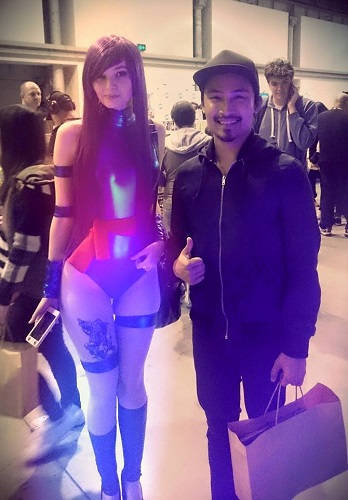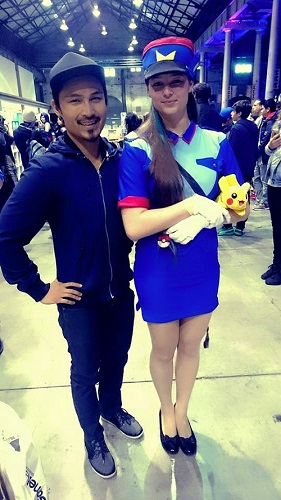Insights From Game|On Showcase – How Games Engage Customers

There’s a reason brands have been lusting after gamification and at the Game|ON Showcase as part of the Vivid Festival in Sydney Jazz Ocfemia, OMD insights manager, went along and gives us all the goss on why it’s such a crucial marketing element.
As an obsessively digital native, gaming geek, and square-eyed YouTuber, it was only natural that I would instantly smack the like button for the opportunity to attend the Game|ON Interactive Games and Online Video Showcase last weekend.
It was the first event of its kind in Australia, uniting two interactive and innovative industries – the games industry for casual gamers, developers and experts, and the online video world for creators, brands and enthusiasts. This, and it also brought creators out from the other side of the screen and into the realm of their consumers. (I totally met ChampChong, Psylocke and Officer Jenny!)


*ahem* There was a lot showcased, and below are a few short form take outs from the intriguing and thought-provoking panel discussions and future-forecasting presentations:
Sweet, Sweet, Gamification:
The use of game mechanics, ‘gamification’, has now been around for several years and is still a key tool to engage customers.
Without a doubt, Candy Crush has been one of the most successful examples of gamification, and when you unwrap the enticing game packaging, you unveil a deliciously smart business model. This combination of a successful business framework with social and rewarding game mechanics has made Candy Crush what it is today – it is simple, familiar and habitual.
However, gamification is not a magic tool. Like many things, it should only be used when it is relevant and appropriate. One metaphor that Jennifer Wilson from The Project Factory sweetly used was that gamification is like chocolate sauce – it’s amazing, absolutely amazing, but it doesn’t go with everything – it’s divine on ice cream, but disastrous on blue cheese.
So when you find that framework, only layer on some game mechanics when it provides value and utility to the consumer.
Plugging Into The World of VR and AR
The VR (virtual reality) and AR (augmented reality) worlds are definitely hotting up with the announcements of a plethora of systems such as PlayStation’s “Project Morpheus”, Microsoft’s Hololens and the HTC Vive.
But one of the most intriguing and secretive developments has got to be Magic Leap’s work with the WETA Workshop (of Lord of the Rings fame). One of the issues with VR and AR, is that many technologies rely on you to view projections on a small screen or pane of glass (in the case of the now retired Google Glass), which usually results in ghostly or blurry images because the real world also brings in a whole range of light into your eyes.
Magic Leap, however, has been developing technology that reflects light into your retina, projecting sharp images that are indistinguishable from real world information.
Imagine this: before you even go up to talk to someone – seeing their tweets, events they have RSVP’d to and latest Facebook photos pop up around them in preparation for actual face-to-face contact. Or a Total Recall-esque product of curated virtual reality experiences developed by renowned film director, David Lynch (actually. freaking. happening!). The applications for film, gaming, travel and communications are fantastical yet close on the horizon.
Which all makes me think: What will be reality … when digital worlds are part of our reality? Will our analogue perceptions be intermixed with digital projections? And can it completely overtake our analogue realities? It’s a brave new world that will be exciting to explore.
The Future of Interactive Advertising
The current buzzword in advertising is definitely ‘programmatic’. However, it’s definitely not just a buzzword, but a seismic shift in the way we buy media today – with digital trading desks becoming more and more common and trusted for delivering premium inventory, and TV and out-of-home hot on its binary heels.
A common misconception around programmatic, though, is that communication will become procedural and robotic, with little room for creativity. However, this is definitely not the case – as Dany Milham from Data @ Ogilvy says, “programmatic can be creative because it is so targeted.” With the amount of data we can track and the specificity of how we can target, we must ensure messages remain relevant and engaging to our audiences when programmatically buying and not just broadly produced.
Media, advertising, and all activities in between are still going to be ideas-oriented, but can now be partnered with more efficient buying methods and all the rich data we can collect for data-driven optimisation and creation.
Please login with linkedin to comment
Discovery CommunicationsLatest News

TV Ratings (18/04/2024): I’m A Celebrity Wins Prime Time And Key Demos
Aussie viewers can be a harsh lot at times. Only days after Ellie Cole bled her heart out, she has been sent packing.

Effie&co Launches New ConnectAsia Division To Help Aussie Brands Market To Asian Consumers Overseas & At Home
Not provided is advice on using chopsticks and not spilling ramen down your shirt.

Cashrewards Sets Out Stall For New CMO
Thinking of applying for the Cashrewards CMO gig? Here are some insider tips that, yes, are tantamount to cheating.

‘I Ask For The TV Industry To Stand Up And Defend Itself’ – Seven Boss James Warburton Steps Down
The Seven supremo heads for the exits after five years. Here's hoping the Spotlight team organised the farewell bash.

Poh! Jamie! Adriano! Paramount ANZ reveals its tasty plans for this year’s MasterChef
It's your fan's guide to this year's MasterChef! Although no tips on how to pronounce crudités or use a un fait-tout.

Dentsu’s iProspect Partners With MOOD Tea Ahead Of May Campaign Launch
We love a Mood Tea here at B&T. Although we do store old screws and nails in the International Roast caterer's tin.

Opinion: When Culture Starts Eating Itself: Navigating The Age Of Self-eating Nostalgia
Born boss David Coupland asks is adland going through a nostalgia period? But please, no repeats of Best Of Red Faces.

Who’s Going To Cannes?! The TikTok Young Lions Winners!
It's Aussie adland's next gen! They're off to Cannes with high hopes of bringing back a Lion & a foot-long Toblerone.

Adobe Launches Express Mobile App With Firefly AI
Want to be the coolest kid at Friday staff drinks but forgot your retro Nikes? This new Adobe wizardry may do the trick.

ThinkNewsBrands & IMAA Extend News Publishing Education In Brisbane
Industry duo takes its publishing roadshow to Brisbane. Was disappointed no male attendees were wearing walk socks.

B&T Chats With Wavemaker’s Provocative Pioneers On Their Cross-Pacific Sojourn
B&T TV heads to Wavemaker's Sydney digs to interview two staffers from its New York & LA digs. If that makes sense?

HoMie & Champion Launch “Give One. Get One” Campaign Supporting Youth Homelessness Via Town Square
Much like the fête's prized chutney wears a blue winners sash, so too should this top initiative from HoMie & Champion.

Thinkerbell Takes Us Back To Summer In Latest Work For XXXX
This beer ad wants to take you back to summer! Just minus any chance of a shark attack on your morning bus commute.

Cannes Lions Unveils 2024 Programme Featuring Queen Latifah, Jay Shetty & P&G’s Mark Pritchard
Are you one of the lucky ducks heading to Cannes in June? Check out the headliner acts you'll be queueing hours to see.

Scroll Media Recruits Costa Panagos From Twitch
Costa Panagos set to bring South American flair to the Scroll offices. Assuming that he is, indeed, South American.

Year13, Microsoft & KPMG Australia Launch AI Course For Gen Zs
Born around the 2000s? Need to amp up your AI creds? This guide's for you (although it's not really that age specific).

General Motors Snares Heath Walker From Scania
Do you rage about oversized American cars on our roads? You need to bail up Heath Walker at parties & industry events.

VML Launches New “Envoyage” Brand For Flight Centre
VML unveils new brand for travel operator Flight Centre. Alas, no sign of those paid actors pretending to be pilots.

Subaru Places Media Account Up For Review
Subaru puts media up for review, as adland journos get set for mandatory "agency drives off with..." headline.

TV Ratings (17/04/2024): Contestants Faced With Harsh Realities As Alone Australia Heats Up (Or Cools Down)
Alone still doing the business for SBS. Overly long train journeys not doing the business, but they persist anyway.

Ben Fordham Loses Number One Spot As Ray Hadley Celebrates 156th Ratings Win
The radio numbers are in! Discover who's off for a boozy lunch today & who's waiting for the dreaded HR death knock.

Gourmet Ice Cream Brand Connoisseur Launches New “Thrill Your Senses” Iteration, Via SICKDOGWOLFMAN
Rattling the old "truth in advertising" adage comes this ice-cream spot full of noticeably thin people.

Paramount’s Global Sales Boss: ‘Australia’s Converged Model Is A Blueprint For How I’d Like All Of Our Markets To Be’
Paramount's global sales boss gives local sales ops the thumbs up. Didn't weigh-in on the Lisa Wilkinson debacle.

TikTok Starts Testing Its Instagram Rival In Australia
In exciting news for piano playing cats & brattish pranks in shopping centres, TikTok unveils its Insta rival plans.

Man Wrongly Named By Seven As Bondi Killer Hires Lawyers
Struggling to save for a house deposit? Why not get wrongly identified by Sunrise!

Smartsheet Appoints Indie Agency Sandbox Media To Its Media Account
Can't stand your colleagues? Like to dob them in when they miss a deadline? These work management platforms are ideal.

Boss Not Letting You Come To Cannes In Cairns? Use This Business Case To Convince Them!
Stingy boss won't spring for a ticket to Cairns? Add this to your persuasive argument repertoire. Or grovel.

Alt/shift/ Brisbane Builds Portfolio With Ausbuild Creative, PR, Content & Social Account Win
The Brisbane comms/PR agency lands constructor Ausbuild. Also hoping for a discount on its new glass conservatory.

Young Guns Versus The Old Guard: Who Adds More Value to Our Industry?
Cannes In Cairns poking this hornet's nest in a lively debate. Just so long as the oldies can get up the stairs.

70% Of Aussies Don’t Have Green Power Plans ENGIE Says In Major Brand Campaign Via HERO
Are you the notorious "light leaver on-er" in your flatshare? Quell any infighting with this green energy news.

PrettyGood Launches Offering Brand & Media Solutions For Australasian SMEs
B&T applauds the charitable nature of this new agency. Although we'd hate to see it impact any Chrissie present sends.

A Blunt End: Dolphins Medicinal Cannabis Sponsorship At Risk
Yes, it's another NRL drug story. Yet, thankfully it doesn't involve coke in Kuta during the off-season.

Slew Of New Creative Hires At Leo Burnett Australia
Ahhh, all black! The outfit of choice for agency creatives, David Jones staff and everyone in Melbourne.

Under Armour Unveils Local “Live in UA” Campaign
American apparel brand set for yet another tilt at the Aussie market, as Nike declares "we'll see about that".

Pepsi Launches New Look, Refreshing Classic Fashion Staples Via Special PR
Are you always the bridesmaid, never the bride, as the old saying goes? How do you think Pepsi feels?

Pure Blonde Returns To A Place Purer Than Yours In New Campaign Via The Monkeys
B&T's always been a huge fan of the 'drink yourself thinner' diet plan. So big thanks to Pure blonde, vodka & tequila.

